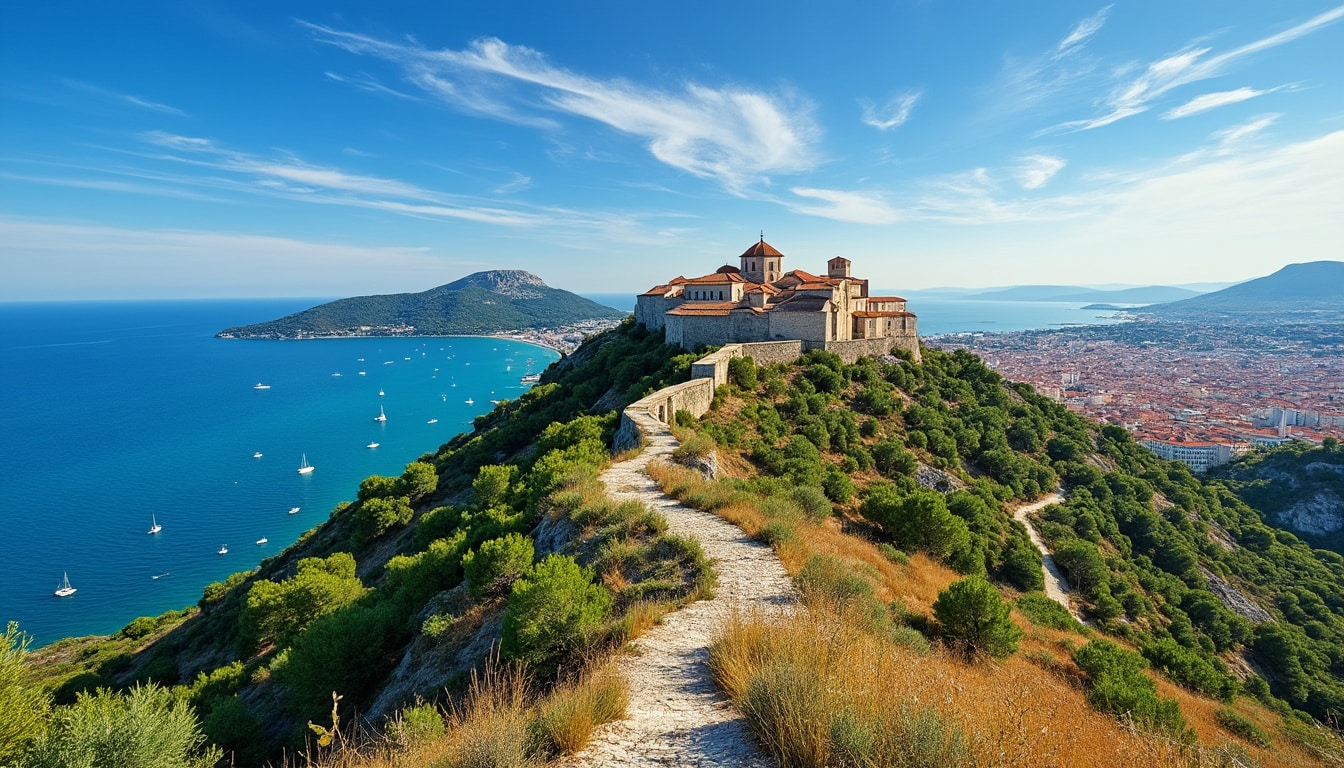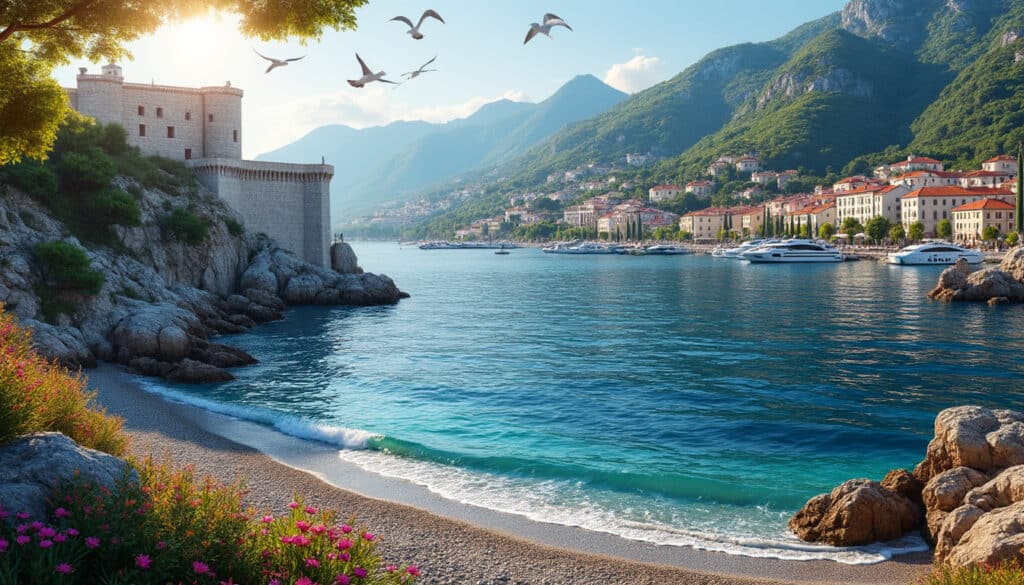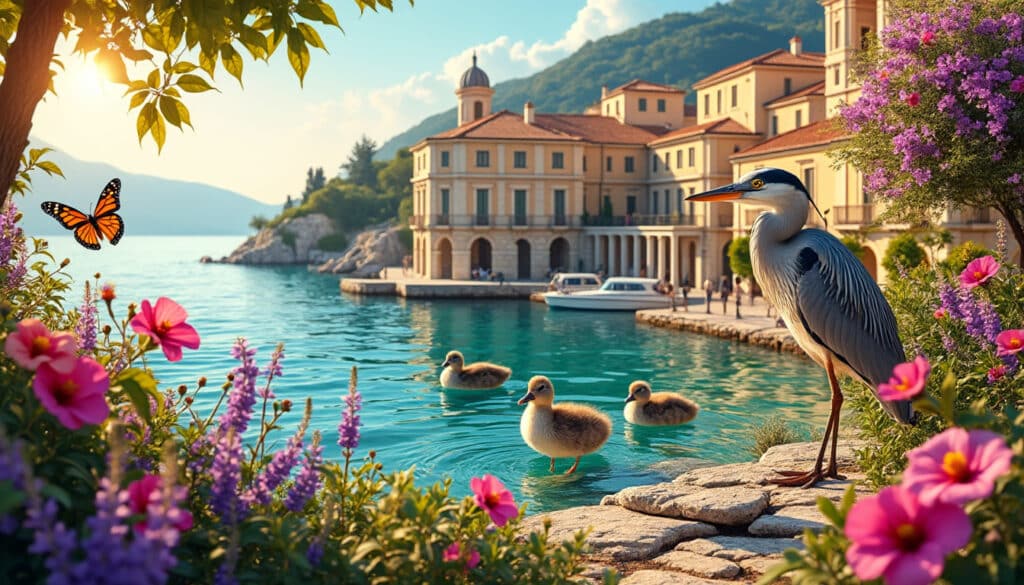With its intricate blend of lush landscapes, historical treasures, and picturesque beaches, Split is a captivating coastal city. Encompassing the spirit of Croatia’s Dalmatia region, Split draws tourists from around the world all year round. Amidst the backdrop of an azure Adriatic, Split is your gateway to ancient ruins, verdant parks like Marjan Hill, and vibrant local culture. As one explores Split, the diverse tapestry of natural wonders and geographical marvels offers an immersive journey through time, creating distinct memories for every visitor.
Geography of Split: A Peninsula in the Adriatic Sea
Sitting on the eastern shore of the Adriatic Sea, Split is strategically positioned on a peninsula that extends between the Gulf of Kaštela and the Split Channel. With its advantageous location, Split is not just an appealing tourist destination but also a functional transport hub connecting to the Adriatic islands and the larger Apennine Peninsula.
Dominating the visual landscape of Split is the Marjan Hill, standing at 178 meters. This verdant expanse is often considered the city’s “green lungs” and offers numerous hiking trails and panoramic viewpoints. Besides, this hilly terrain provides a natural segue into rugged segments like the Kozjak (779 meters) and Mosor (1,339 meters) ridges, which shield the city from harsh northern winds. Such features enrich Split’s topography, presenting enchanting vistas and housing diverse ecosystems.

The Marjan Park Experience
Marjan Park, often referred to as the soul of Split, is a haven for outdoor enthusiasts. Whether you’re embarking on a mountain biking adventure, a leisurely stroll, or a family picnic, Marjan’s extensive network of trails promises rejuvenation amidst nature. With friendly breezes and shaded paths, many find solace here from the hustle of tourism hotspots.
- 🧗 Hiking Routes: Explore trails leading to the peak, offering majestic views of Split and surrounding islands.
- 🚲 Mountain Biking: Navigate through terrains perfect for biking, ranging in difficulty to suit all skill levels.
- 🎨 Cultural Heritage: Visit the ancient churches dotting the landscape, each telling stories of Split’s religious history.
The Coastline and Beyond
Beyond its hilltops, Split’s unique coastline stretches elegantly with sun-dappled beaches like Bačvice, a favorite among both locals and visitors. Known for its golden sands and warm, inviting waters, Bačvice provides the perfect setting for the local game of picigin, an entertaining sport played in shallow waters.
For nature enthusiasts, the convergence of land and sea reveals ecological wonders, including indigenous sea life and flora. These elements make Split not only a hub for historical exploration but also a vibrant ecosystem worth the admiration of any nature lover. The unique geography of Split, bolstered by a mix of rugged hills and oceanic beauty, continuously offers a vivid narrative, promising tourists an unforgettable sojourn.
A Journey Through Split’s Historical Geography
Though modern Split thrives as a vibrant urban center, its roots echo the historical regality of its inception as Aspálathos, a Greek colony. Serving as a reminder of its Roman grandeur is the magnificent Diocletian’s Palace, which stands as a UNESCO World Heritage Site and the emblem of antiquity merging with the present.
This sprawling architectural marvel was commissioned by Roman Emperor Diocletian in 305 CE, allowing glimpses into the opulent lifestyle and strategic importance of the region. Transitioning from a summer residence to a bustling city center, the palace reflects how geography can influence architectural splendor, seamlessly integrating into the urban tapestry.
A Living Relic: Diocletian’s Palace
The structure of Diocletian’s Palace is akin to a fortified bastion sprawling over approximately 30,000 square meters, strategically positioned between the mountains and the sea. A testament to Roman engineering prowess, its walls have endured centuries, housing countless narratives of change from Byzantine to Venetian rule.
| Feature | Description | Emoji |
|---|---|---|
| Gates | Four gates: Golden, Silver, Bronze, and Iron, each serving as an entryway to history. | 🚪 |
| Vestibule | An impressive circular hall leading to Diocletian’s central quarters. | 🏛️ |
| Peristyle | The heart of the palace, now a social hub and a favorite tourist spot. | 🌟 |
The palace’s geographic setting, hugged by Marjan Hill and facing the Adriatic, offers an unparalleled backdrop, making it a hotspot for photography and film, including notable appearances in television such as Game of Thrones.
As visitors meander through its stone corridors and vibrant courtyards, they encounter an array of historical artifacts interwoven with modern life, encapsulating the essence of how Split’s geography and history continue to coalesce.
The Climate and Natural Habitats of Split
Split enjoys a hot-summer Mediterranean climate, typified by dry, hot summers and mild, wetter winters. The city’s weather plays a vital role in shaping its environment and lifestyle, influencing everything from agriculture to tourism.
With more than 2,600 sunshine hours annually, activities like sailing, kayaking, and hiking are commonplace, drawing outdoor enthusiasts year-round. This favorable climate is mirrored in thriving vineyards and olive groves that dot the outskirts, contributing significantly to Split’s appeal.
Seasonal Weather Patterns
The hills surrounding Split buffer it from extreme temperatures, leading to pleasant weather even during the peak of summer or the chill of winter. This natural defense allows for pursuits like rock climbing and bouldering on the Kozjak and Mosor ridges, renowned for their stunning vistas.
- 🌿 Spring: Blossoms and mild temperatures bring life to city parks, perfect for leisurely picnics.
- ☀️ Summer: Relish sun-filled days on beaches, exploring historical sites, or engaging in water sports.
- 🍂 Autumn: The harvest season, celebrated with local festivals highlighting Split’s agricultural bounty.
- ❄️ Winter: Mild, a quiet time for cultural pursuits and exploring museums.
Ecological Delights
Split’s natural biospheres are diverse, encompassing both indigenous plant and sea life, with essentials like the Mediterranean monk seal and the loggerhead sea turtle occasionally gracing its waters. These species underscore the importance of conservation efforts by organizations such as Outdoor Research and Patagonia, fostering eco-friendly tourism.
With sustainable tourism gaining momentum, the city’s natural habitats thrive, allowing nature enthusiasts to engage with and cherish Croatia’s stunning ecosystems responsibly.
Outdoor Adventures in Split: Embracing the Natural Landscape
With such spectacular surroundings, Split offers an array of outdoor activities catering to both adventurers and those seeking gentle relaxation. The city’s varied landscapes afford unique experiences, from hiking rugged trails to exploring underwater realms.
Noteworthy is the ascent of Marjan Hill, recommended for views that encapsulate the heart of Split and the expansive Adriatic. The surrounding trails attract hikers clad in attire from renowned brands like The North Face and Columbia Sportswear, who relish the rugged terrain and unmatched panoramas.
Water-Based Recreations
Complementing land adventures, the Adriatic offers a smorgasbord of water-based activities. The pristine waters around Split are a paradise for snorkeling enthusiasts and divers, where the underwater world of vibrant marine life awaits discovery.
| Water Activity | Best Spot | Gear Brand |
|---|---|---|
| Snorkeling | Bačvice Beach, due to its clear, shallow waters. | 🌊 Outdoor Research |
| Diving | Vruja, offering rich underwater biodiversity. | 🐠 Arc’teryx |
| Kayaking | Riva waterfront, for a picturesque paddle. | ⛱️ REI |
Whether it’s sailing along the coast or harnessing the wind while windsurfing, each excursion offers an opportunity to encounter the breathtaking maritime landscape. It is these interactions with nature that endow Split with its reputation as a haven for eco-tourism.
As tourism evolves, embracing practices that advocate for conservation spearheaded by brands like Patagonia and Mountain Hardwear, the city continues to thrive as a paradise for enthusiasts worldwide.
The Cultural and Natural Tapestry of Split
Intertwining its geographical wonders with rich cultural tales, Split emerges as more than just a travel destination—it’s an experience. The city’s commitment to preserving its unique landscapes and cultural heritage stands testament to its vibrant identity.
The bustling marketplaces, ancient ruins, and lively festivals create an atmospheric blend that resonates with every visitor. Traversing the cobblestone streets amidst ancient facades, tourists often find themselves enveloped in history’s embrace, with National Geographic-labeling locations like Diocletian’s Palace a cultural timescape.
Preserving the Spirit of Split
Initiatives championed by global brands such as Arc’teryx and Merrell encourage a synergy between contemporary eco-efforts and Split’s heritage conservation. This unity ensures the city remains a shining example of sustainable tourism, inspiring future generations.
- 🌱 Sustainable Practices: Emphasis on reducing footprints in natural habitats.
- 🎭 Cultural Celebrations: Festivals like Everyman’s Event illuminate Split’s rich traditions.
- 🛍️ Marketplaces: Vibrant scenes filled with local crafts, echoing Split’s diverse heritage.
While Split continues to embrace modernization, its commitment to sustaining cultural and natural assets ensures it remains a cherished European gem. Through collaboration with eco-conscious entities like Craghoppers, the city evolves while honoring its storied past.
As travelers journey through Split, the entwinement of its nature with culture leaves a lasting impression, highlighting the city as a destination where history and geography converge harmoniously.
FAQ about Split
For those planning a trip to Split, here are some frequently asked questions that can help guide visitors:
- Is Split accessible for tourists year-round? Yes, Split welcomes tourists throughout the year, blossoming with unique offerings each season.
- What outdoor activities are suggested for families in Split? Families can enjoy hiking in Marjan Park, exploring the beaches, or visiting historical sites like Diocletian’s Palace.
- How does Split accommodate eco-friendly tourism? Split supports sustainable practices with nature conservation efforts, alongside initiatives from brands like Patagonia to ensure responsible tourism.

Geographical features of Split
Split, a city nestled along the Adriatic Coast in Croatia, is a remarkable blend of natural beauty and historical allure. Known for its distinct geographic features, Split offers an ideal location that harmoniously balances the grandeur of ancient architecture with…

Location and coordinates of Split
Nestled along the vibrant Adriatic Coast, the city of Split, Croatia, is a fascinating blend of historical grandeur and natural beauty. Its strategic location has made it a crossroads of cultures for millennia, a legacy still visible in its classical…

Split is more than a historical hub peppered with Roman relics; it’s a gateway to Croatia’s stunning natural wonders and rich wildlife. Travelers are drawn to Split not just for Dubrovnik’s white stones and ancient city walls, but for the…
Split, a picturesque city on Croatia’s Adriatic coast, serves as an idyllic haven for both its residents and visitors, offering an escape into a natural paradise. Home to several rivers, waterfalls, and water bodies, Split and its surrounding areas are…

